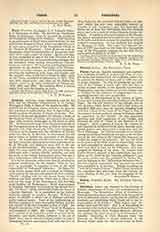

Ferreira, ANTONIO, poet, important both for his lyric and his dramatic compositions, b. at Lisbon, Portugal, in 1528; d. there of the plague in 1569. He studied law at Coimbra, where, however, he gave no less attention to belles-lettres than to legal codes, ardently reading the poetry of classic antiquity. Successful in his chosen profession, he became a judge of the Supreme Court at Lisbon, and enjoyed close relations with eminent personages of the court of John III. Ferreira stands apart from the great majority of the Portuguese poets of his time in that he never used Spanish, but wrote constantly in his native language. Yet he is to be classed with the reformers of literary taste for, like Sa de Miranda, he abandoned the old native forms, to further the movement of the Renaissance. He manifested a decided interest in the Italian lyric measures, already given some elaboration by Sa de Miranda, and displayed some skill in the uses of the hendecasyllable. The sonnet, the elegy, the idyll, the verse epistle, the ode, and kindred forms he vultivated with a certain felicity, revealing not only his study of the Italian Renaissance poets, but also a good acquaintance with the Greek and Latin masters.
It is by his dramatic endeavors that he attained to greatest prominence, for his tragedy “Ines de Castro”, in particular, is regarded as one of the chief monuments in Portuguese literature. He began his work on the drama while still a student at Coimbra, writing there for his own amusement his first comedy, “Bristo”, dealing with the old classic theme of lost children and later agnitions, which was so often utilized for the stage of the Renaissance and has been made familiar by the Shakespeare. Much improvement in dramatic technique is evinced by his second comedy, “O Cioso”, which treats realistically the figure of a jealous husband. It is considered as the earliest character-comedy in modern Europe. Written in prose, it exhibits a clever use of dialogue and has really comical scenes. None of the compositions of Ferreira appeared in print during his lifetime and the first edition of his two comedies is that of 1622. An English translation of the “Cioso” made by Musgrave was published in 1825. His tragedy, “Ines de Castro”, imitates in its form the models of ancient Greek literature, and shows Italian influence in its use of blank verse, but it owes its subject-matter to native Portuguese history, concerning itself with the love of King Pedro for the beautiful Ines de Castro, an incident which has also been splendidly treated by Camoes in his “Lusiadas”, and has furnished the theme for at least ten Portuguese and four Spanish plays, and over a score of compositions in foreign languages. If tested by the requirements of the theatre, the play is doubtless far from perfect, but the purity of its style and diction ensures its popularity with its author’s compatriots. It was rendered into English by Musgrave in 1826. The rather free Spanish version of 1577 was made on the basis of a manuscript copy of the Portuguese original, for the first Portuguese printed edition is of 1587
J. D. M. FORD

